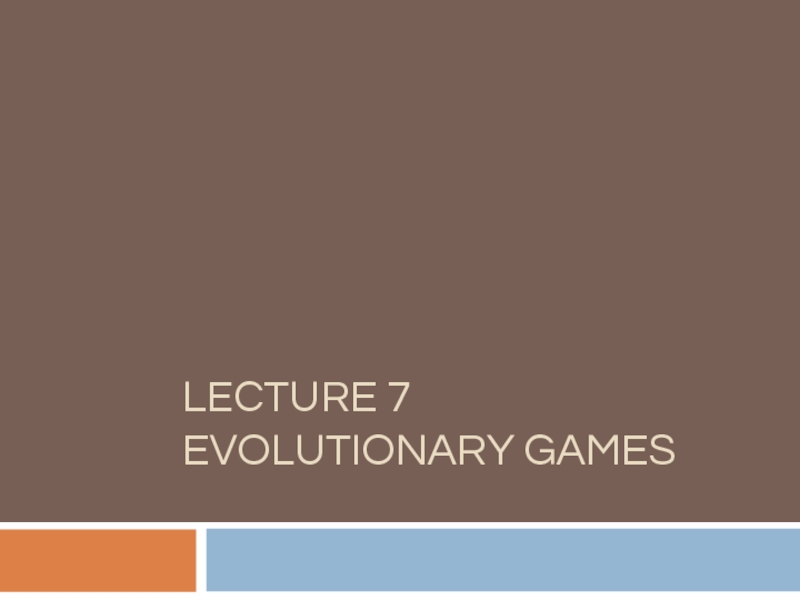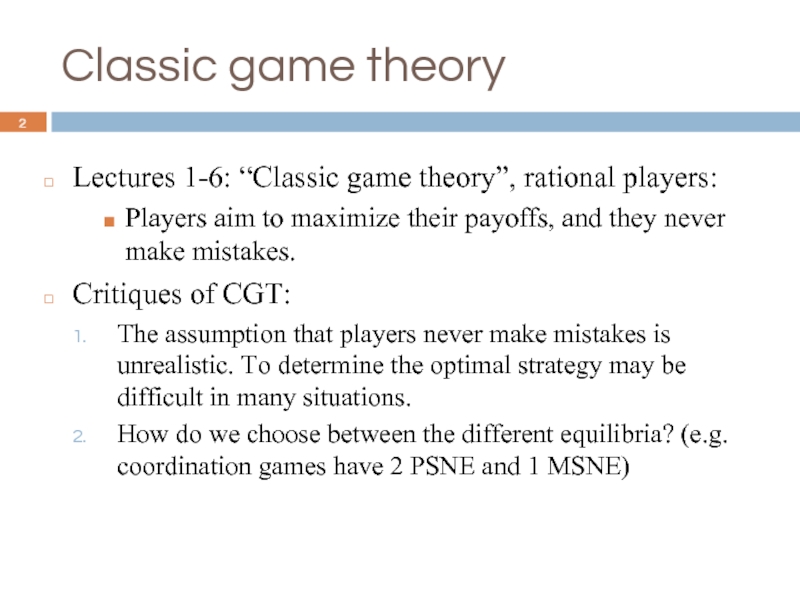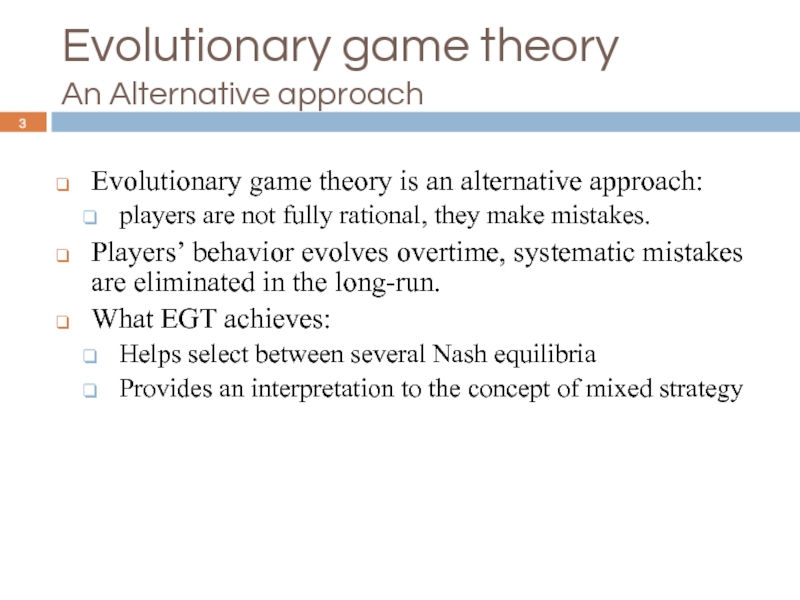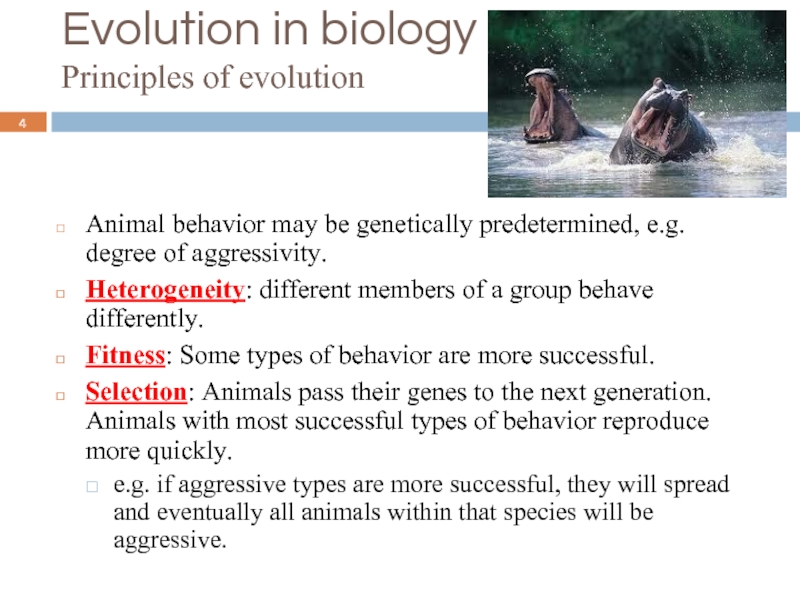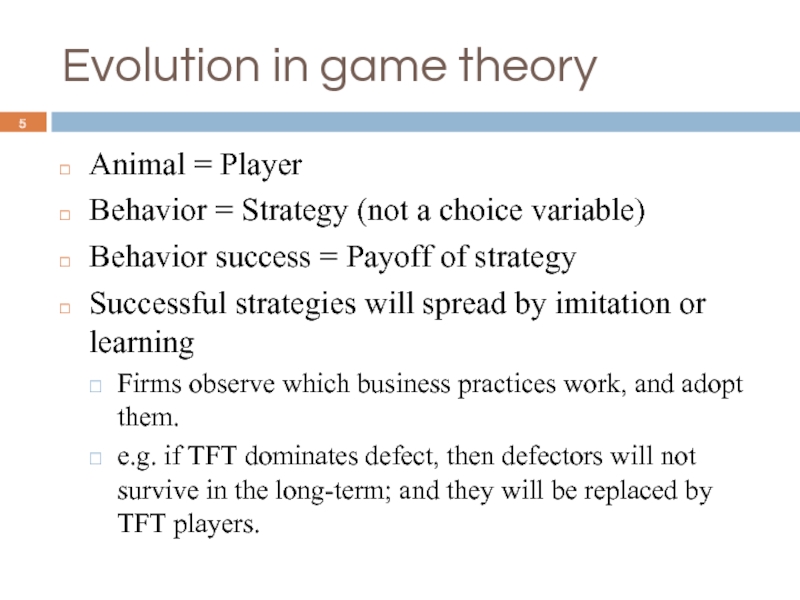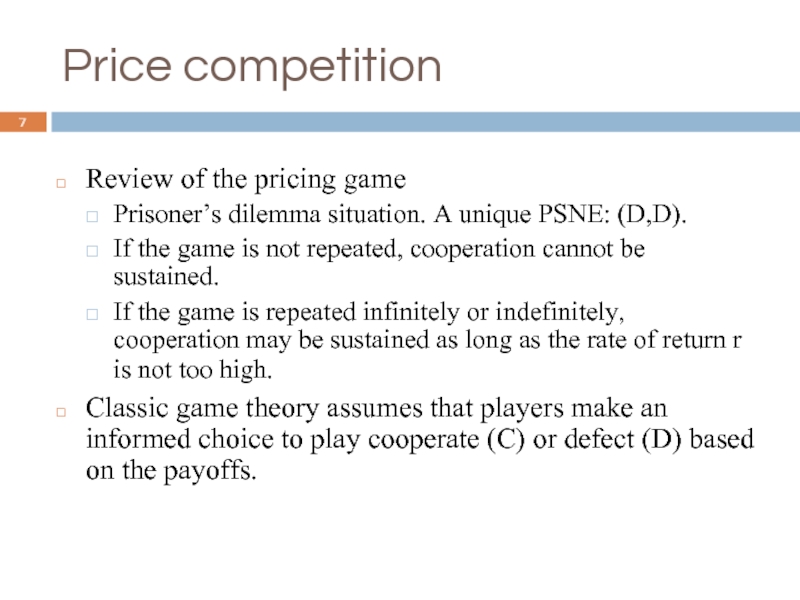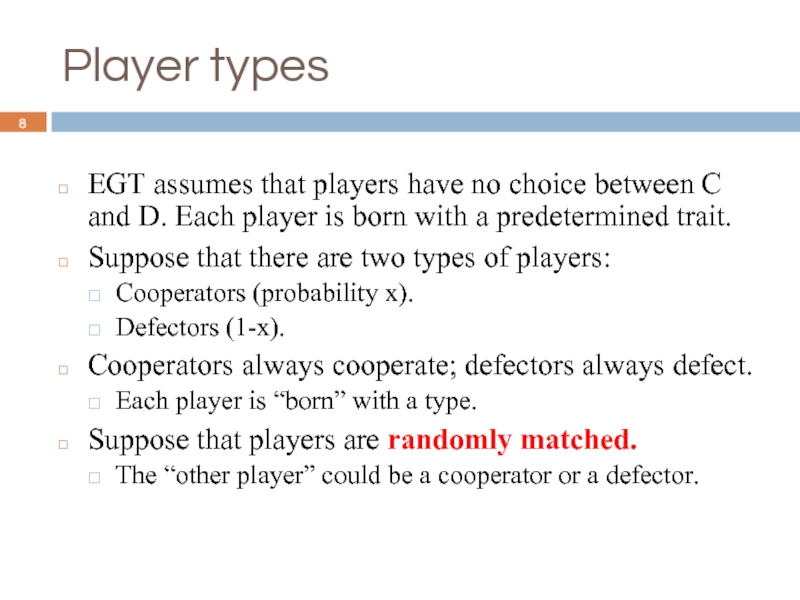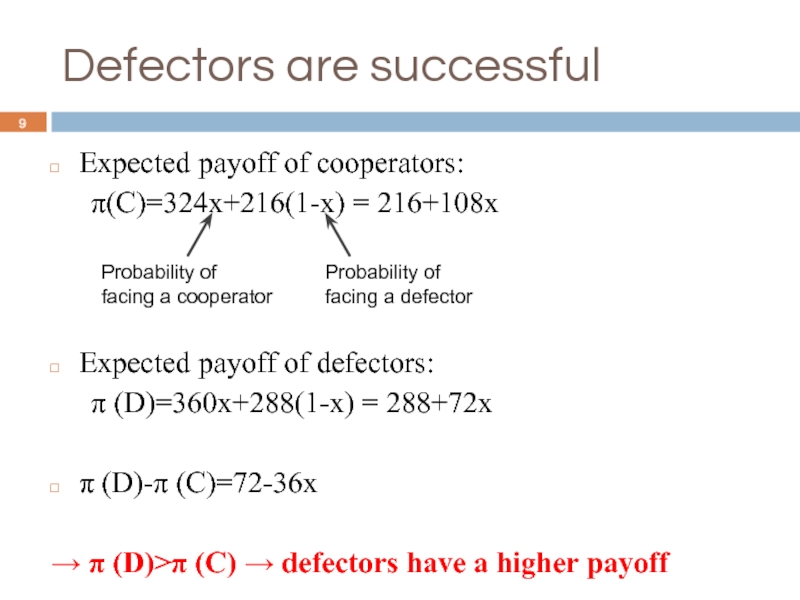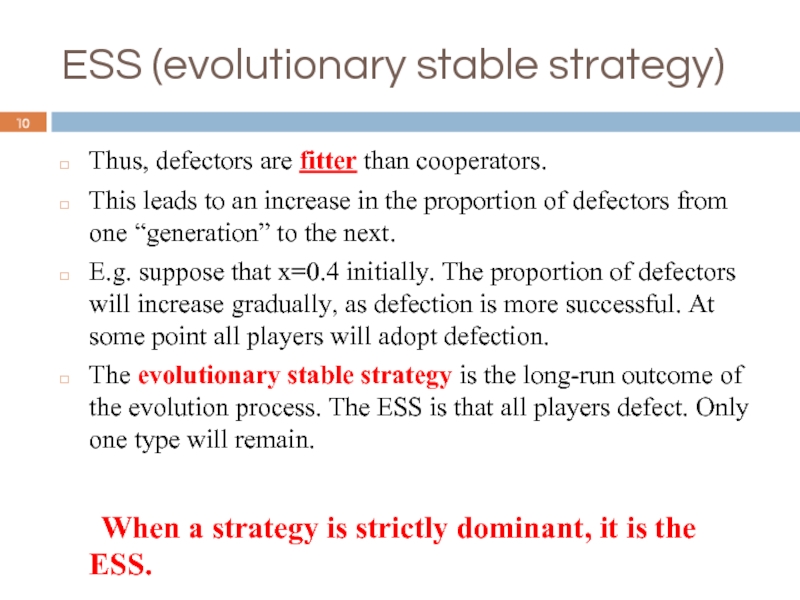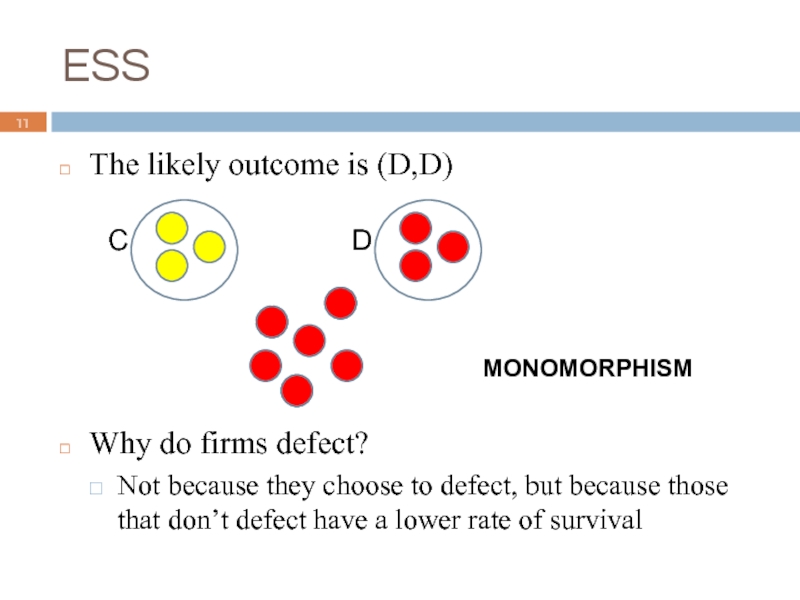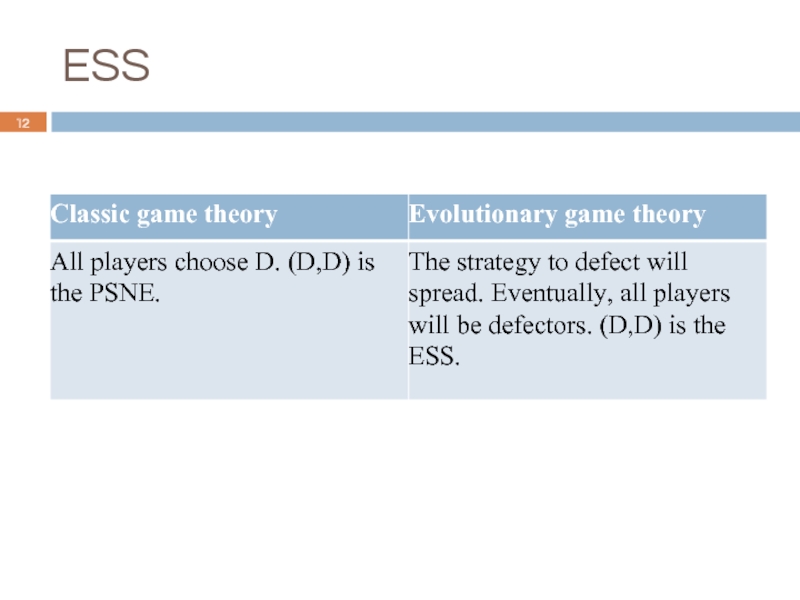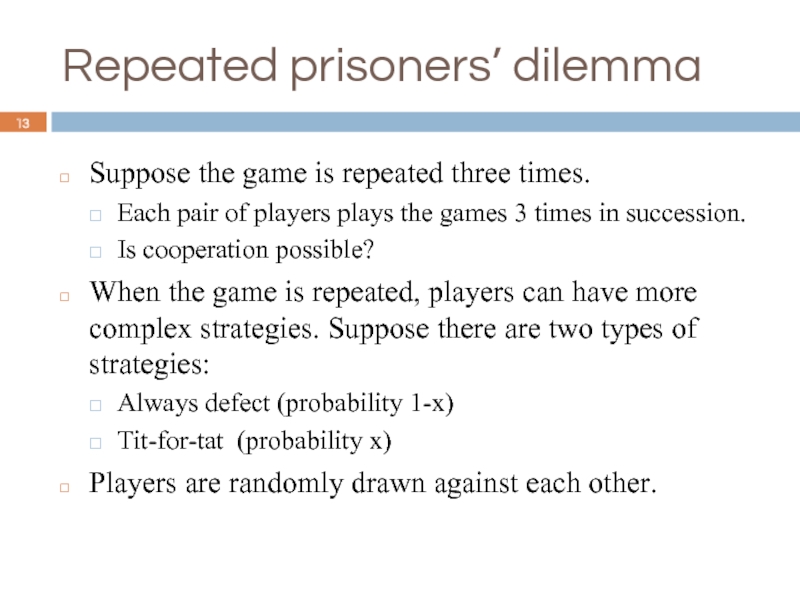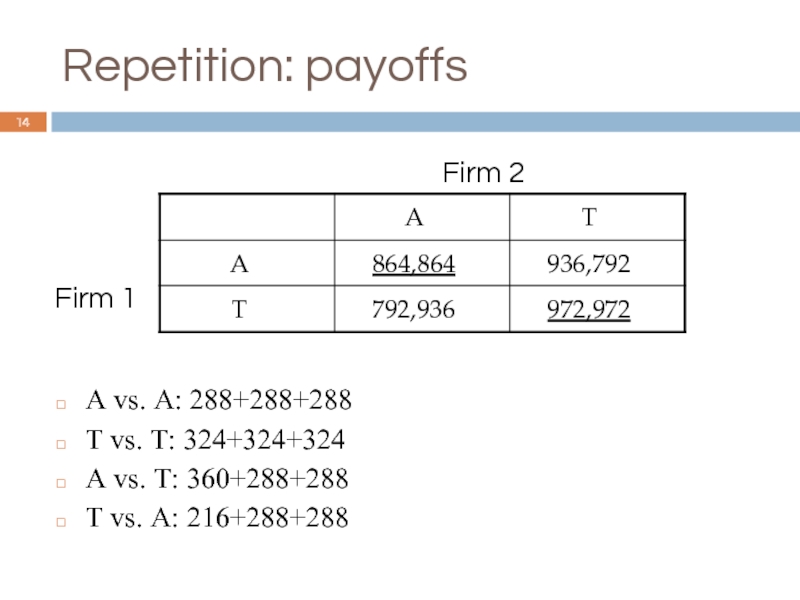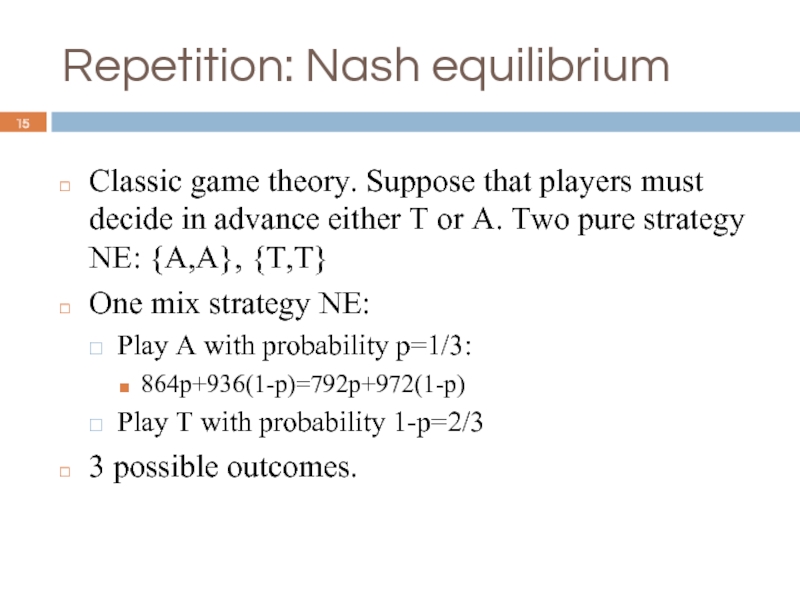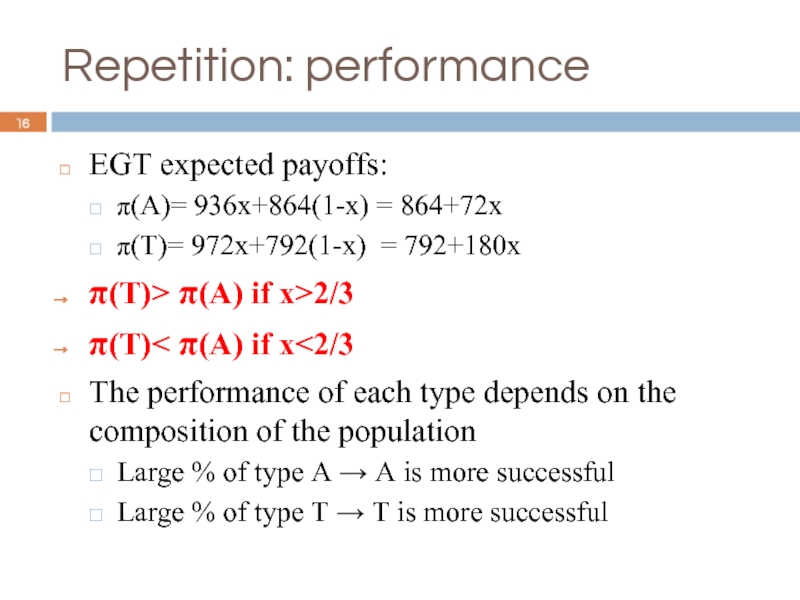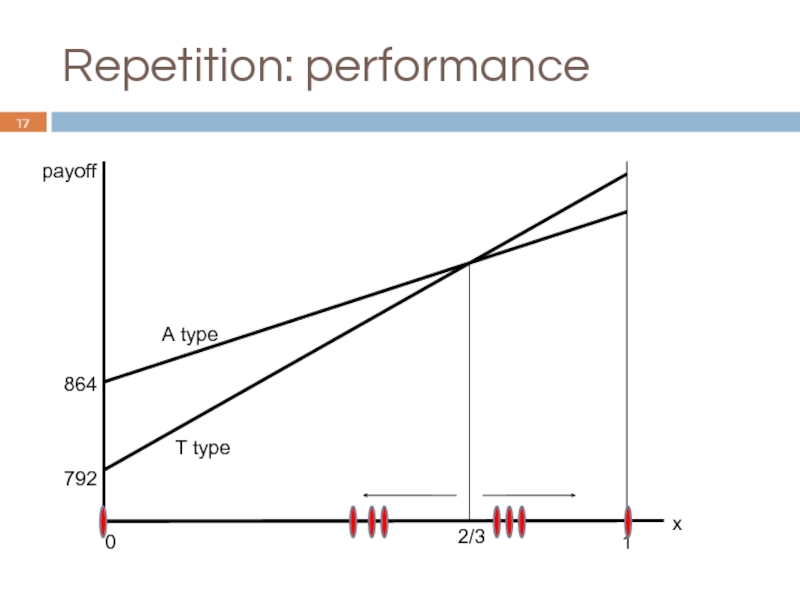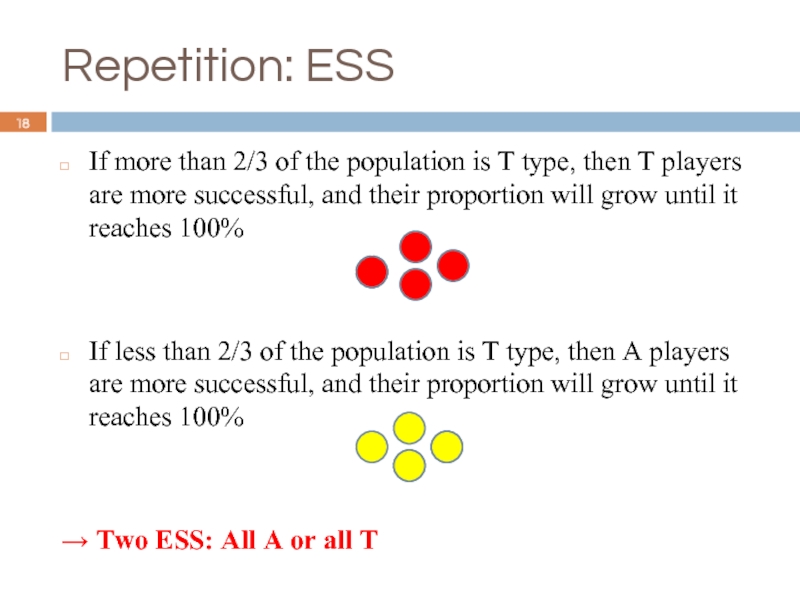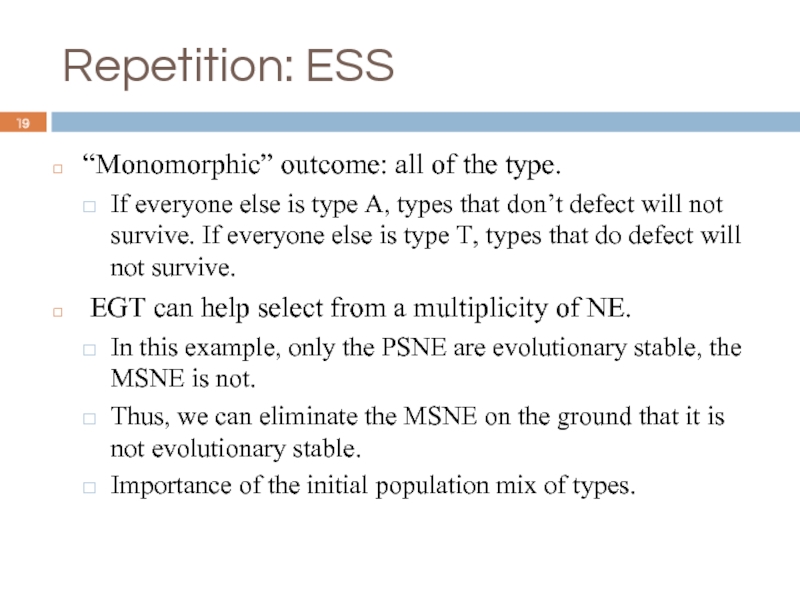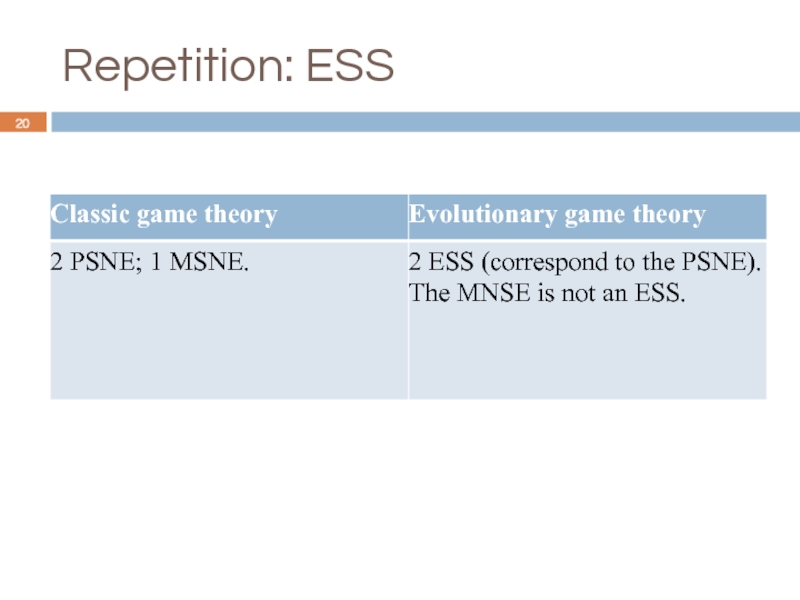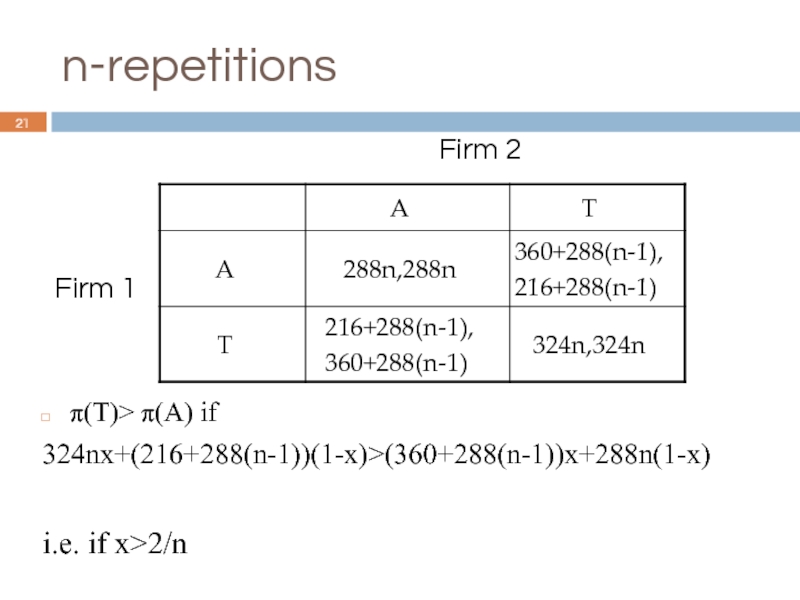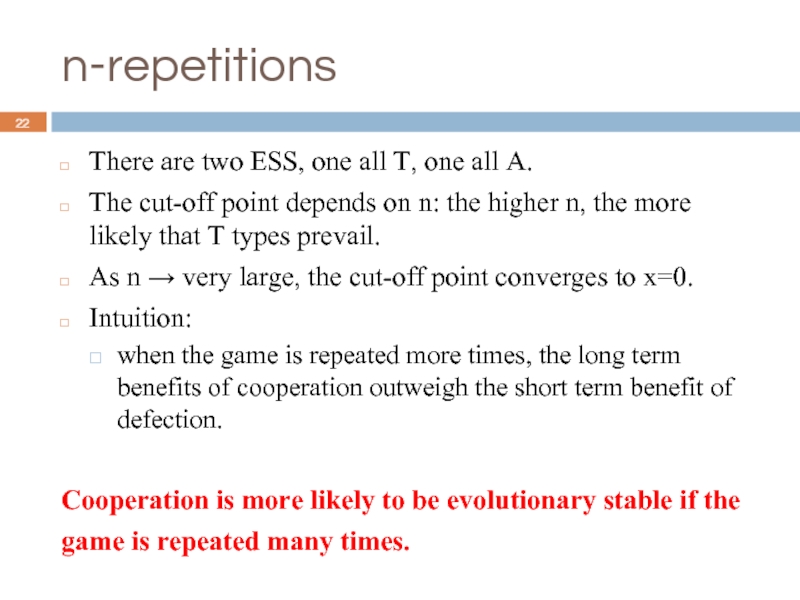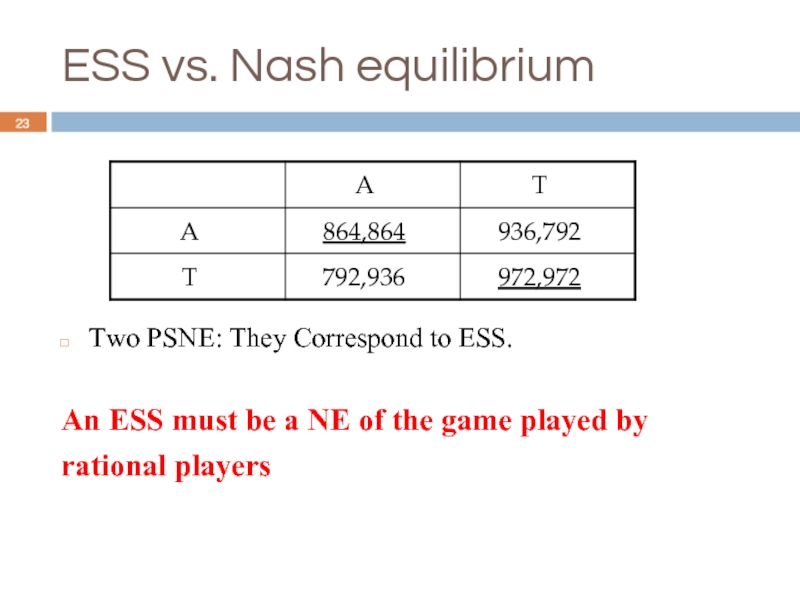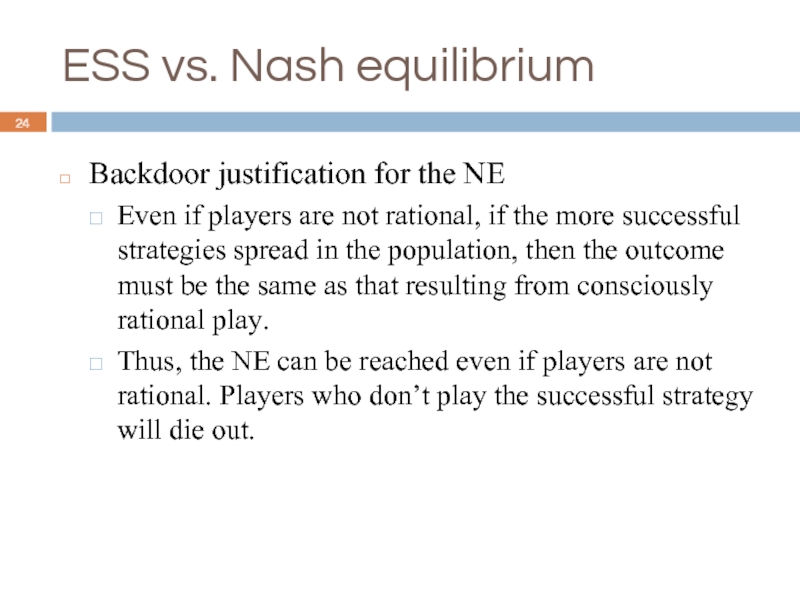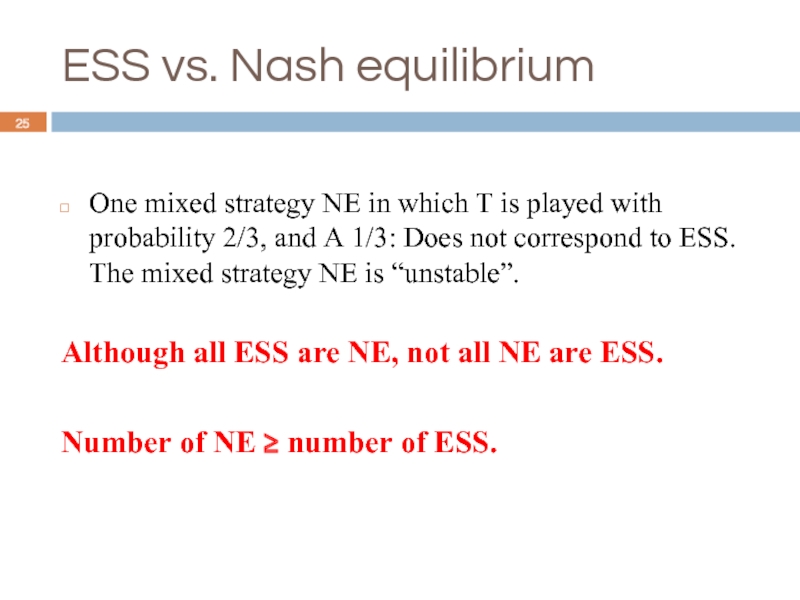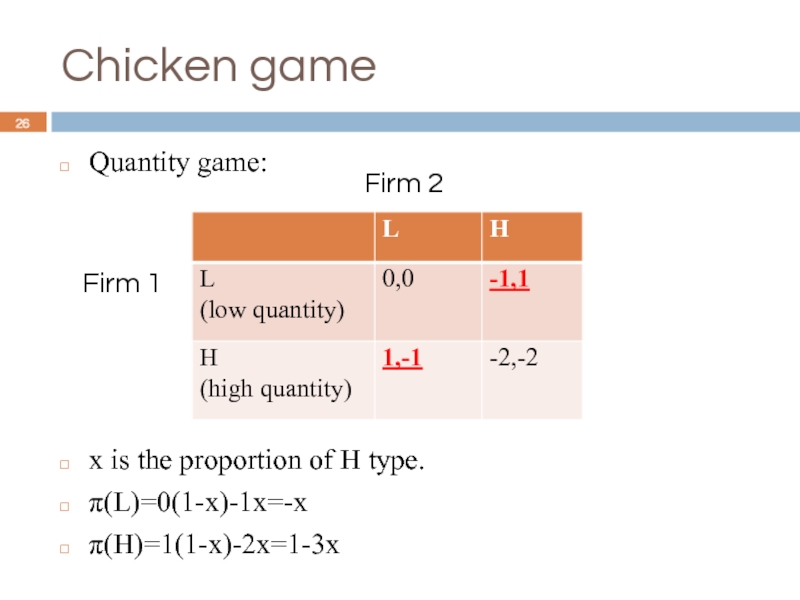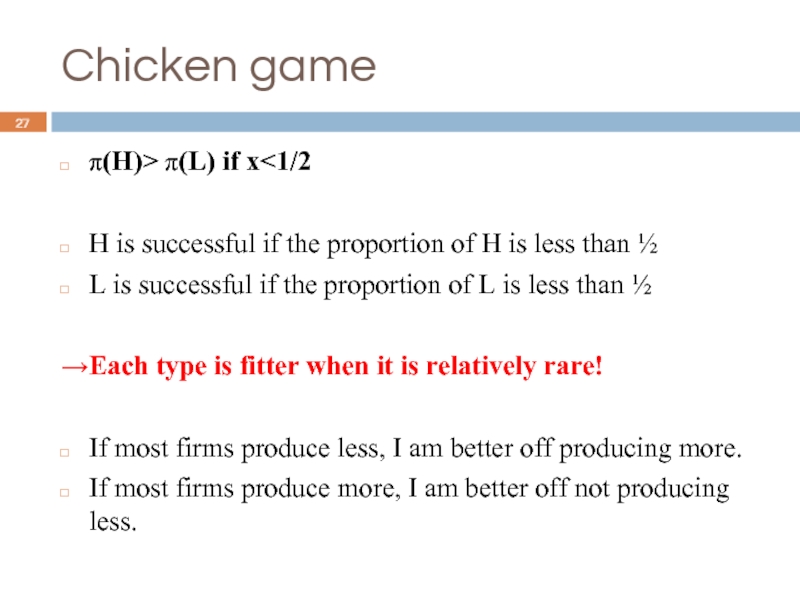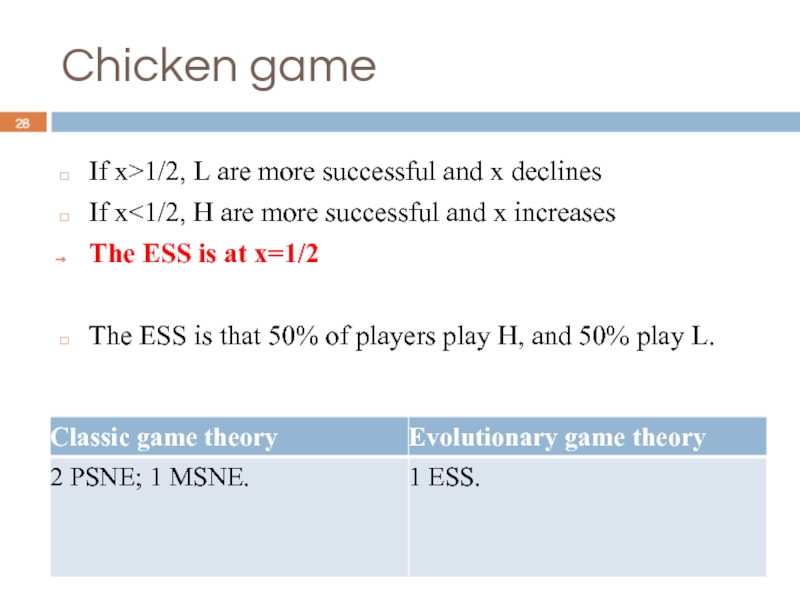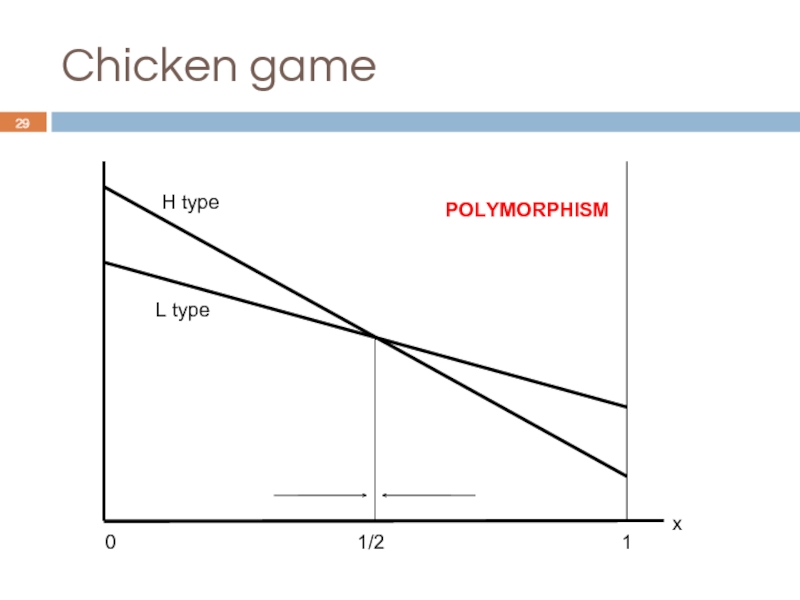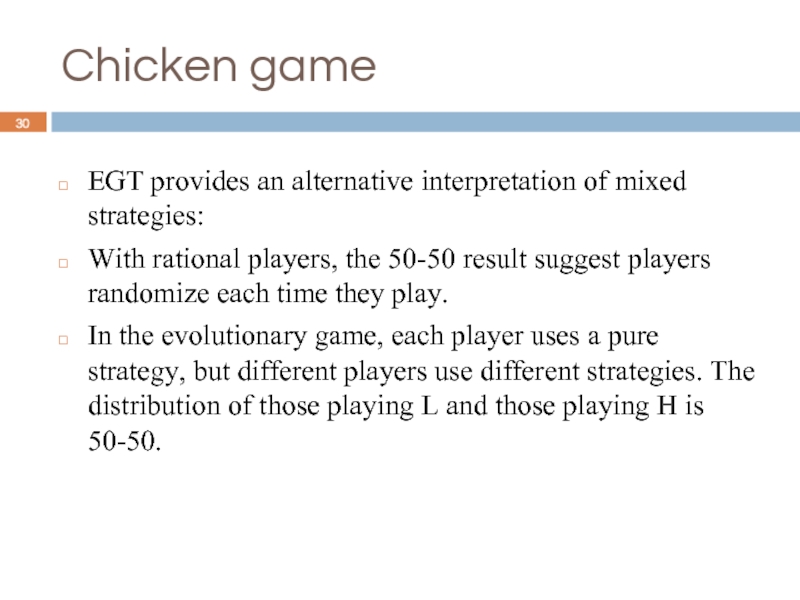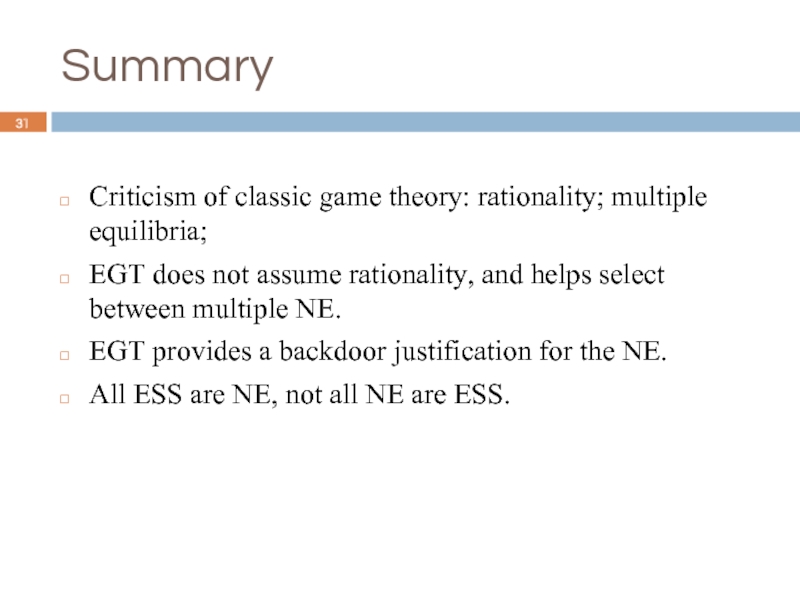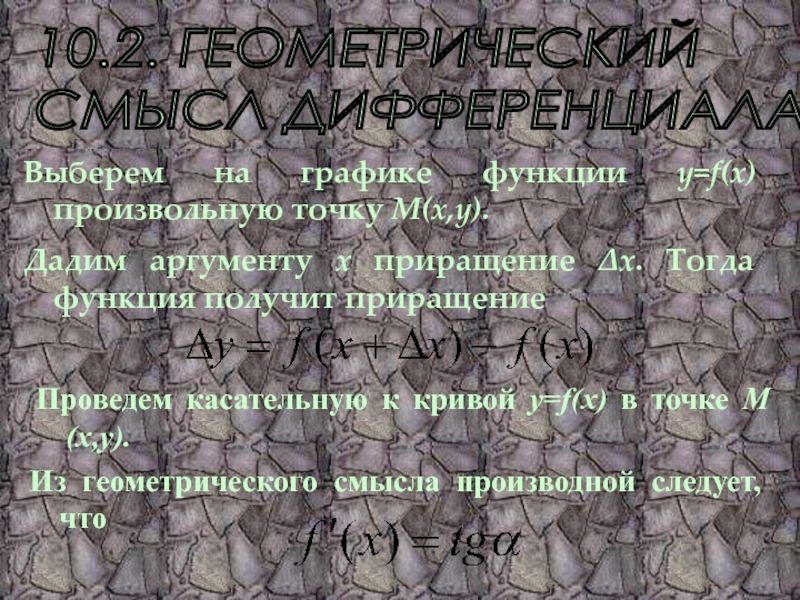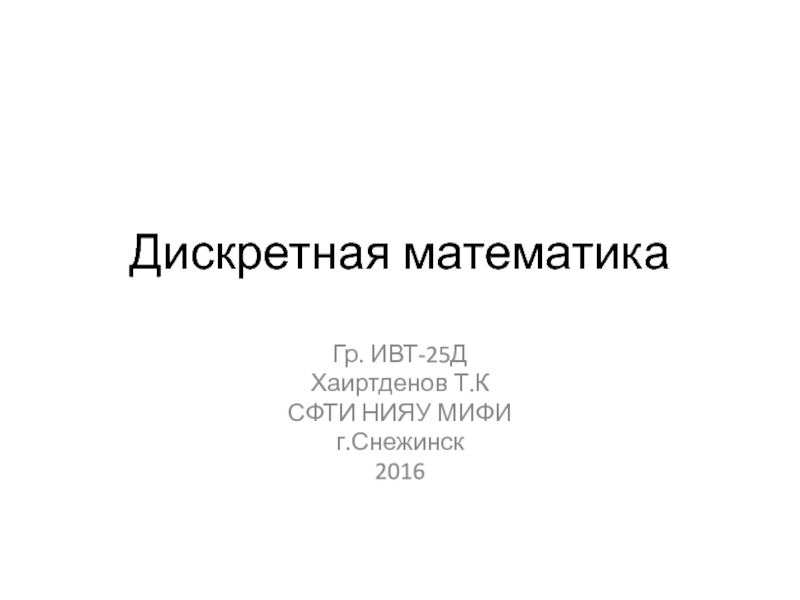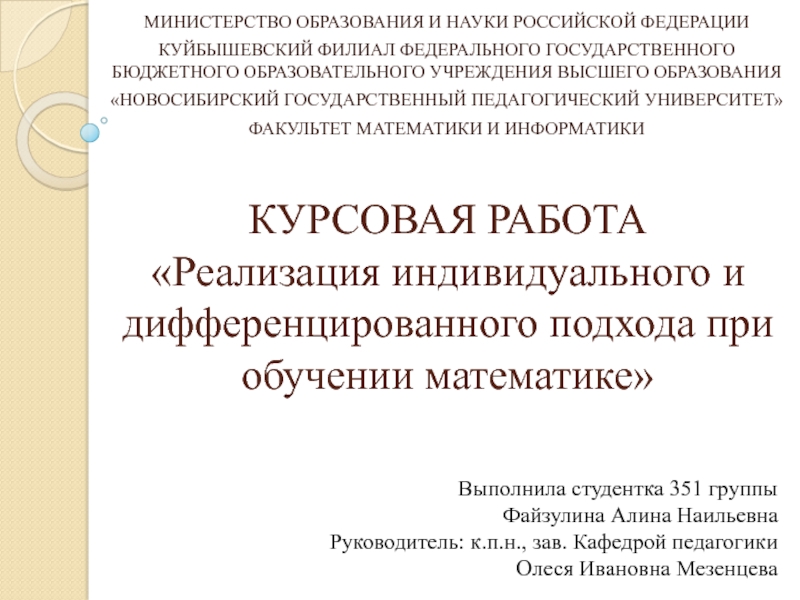- Главная
- Разное
- Дизайн
- Бизнес и предпринимательство
- Аналитика
- Образование
- Развлечения
- Красота и здоровье
- Финансы
- Государство
- Путешествия
- Спорт
- Недвижимость
- Армия
- Графика
- Культурология
- Еда и кулинария
- Лингвистика
- Английский язык
- Астрономия
- Алгебра
- Биология
- География
- Детские презентации
- Информатика
- История
- Литература
- Маркетинг
- Математика
- Медицина
- Менеджмент
- Музыка
- МХК
- Немецкий язык
- ОБЖ
- Обществознание
- Окружающий мир
- Педагогика
- Русский язык
- Технология
- Физика
- Философия
- Химия
- Шаблоны, картинки для презентаций
- Экология
- Экономика
- Юриспруденция
Evolutionary games. (Lecture 7) презентация
Содержание
- 1. Evolutionary games. (Lecture 7)
- 2. Classic game theory Lectures 1-6: “Classic game
- 3. Evolutionary game theory An Alternative approach Evolutionary
- 4. Evolution in biology Principles of evolution
- 5. Evolution in game theory Animal = Player
- 6. Price competition Two firms compete on prices.
- 7. Price competition Review of the pricing game
- 8. Player types EGT assumes that players have
- 9. Defectors are successful Expected payoff of cooperators:
- 10. ESS (evolutionary stable strategy) Thus, defectors are
- 11. ESS The likely outcome is (D,D)
- 12. ESS
- 13. Repeated prisoners’ dilemma Suppose the game is
- 14. Repetition: payoffs
- 15. Repetition: Nash equilibrium Classic game theory. Suppose
- 16. Repetition: performance EGT expected payoffs: π(A)= 936x+864(1-x)
- 17. Repetition: performance 0 A type T type
- 18. Repetition: ESS If more than 2/3 of
- 19. Repetition: ESS “Monomorphic” outcome: all of the
- 20. Repetition: ESS
- 21. n-repetitions
- 22. n-repetitions There are two ESS, one all
- 23. ESS vs. Nash equilibrium
- 24. ESS vs. Nash equilibrium Backdoor justification for
- 25. ESS vs. Nash equilibrium One mixed
- 26. Chicken game Quantity game:
- 27. Chicken game π(H)> π(L) if x
- 28. Chicken game If x>1/2, L are more successful and x declines If x
- 29. Chicken game 0 L type H type 1 x 1/2 POLYMORPHISM
- 30. Chicken game EGT provides an alternative interpretation
- 31. Summary Criticism of classic game theory: rationality;
Слайд 2Classic game theory
Lectures 1-6: “Classic game theory”, rational players:
Players aim to
Critiques of CGT:
The assumption that players never make mistakes is unrealistic. To determine the optimal strategy may be difficult in many situations.
How do we choose between the different equilibria? (e.g. coordination games have 2 PSNE and 1 MSNE)
Слайд 3Evolutionary game theory
An Alternative approach
Evolutionary game theory is an alternative approach:
players are not fully rational, they make mistakes.
Players’ behavior evolves overtime, systematic mistakes are eliminated in the long-run.
What EGT achieves:
Helps select between several Nash equilibria
Provides an interpretation to the concept of mixed strategy
Слайд 4Evolution in biology
Principles of evolution
Animal behavior may be genetically predetermined, e.g.
Heterogeneity: different members of a group behave differently.
Fitness: Some types of behavior are more successful.
Selection: Animals pass their genes to the next generation. Animals with most successful types of behavior reproduce more quickly.
e.g. if aggressive types are more successful, they will spread and eventually all animals within that species will be aggressive.
Слайд 5Evolution in game theory
Animal = Player
Behavior = Strategy (not a
Behavior success = Payoff of strategy
Successful strategies will spread by imitation or learning
Firms observe which business practices work, and adopt them.
e.g. if TFT dominates defect, then defectors will not survive in the long-term; and they will be replaced by TFT players.
Слайд 6Price competition
Two firms compete on prices. The NE is to set
Firm 1
Firm 2
Слайд 7Price competition
Review of the pricing game
Prisoner’s dilemma situation. A unique PSNE:
If the game is not repeated, cooperation cannot be sustained.
If the game is repeated infinitely or indefinitely, cooperation may be sustained as long as the rate of return r is not too high.
Classic game theory assumes that players make an informed choice to play cooperate (C) or defect (D) based on the payoffs.
Слайд 8Player types
EGT assumes that players have no choice between C and
Suppose that there are two types of players:
Cooperators (probability x).
Defectors (1-x).
Cooperators always cooperate; defectors always defect.
Each player is “born” with a type.
Suppose that players are randomly matched.
The “other player” could be a cooperator or a defector.
Слайд 9Defectors are successful
Expected payoff of cooperators:
π(C)=324x+216(1-x) = 216+108x
Expected payoff of defectors:
π
π (D)-π (C)=72-36x
→ π (D)>π (C) → defectors have a higher payoff
Probability of
facing a cooperator
Probability of
facing a defector
Слайд 10ESS (evolutionary stable strategy)
Thus, defectors are fitter than cooperators.
This leads
E.g. suppose that x=0.4 initially. The proportion of defectors will increase gradually, as defection is more successful. At some point all players will adopt defection.
The evolutionary stable strategy is the long-run outcome of the evolution process. The ESS is that all players defect. Only one type will remain.
When a strategy is strictly dominant, it is the ESS.
Слайд 11ESS
The likely outcome is (D,D)
Why do firms defect?
Not because they
C
D
MONOMORPHISM
Слайд 13Repeated prisoners’ dilemma
Suppose the game is repeated three times.
Each pair of
Is cooperation possible?
When the game is repeated, players can have more complex strategies. Suppose there are two types of strategies:
Always defect (probability 1-x)
Tit-for-tat (probability x)
Players are randomly drawn against each other.
Слайд 14Repetition: payoffs
A vs. A: 288+288+288
T vs. T: 324+324+324
A vs. T: 360+288+288
T
Firm 1
Firm 2
Слайд 15Repetition: Nash equilibrium
Classic game theory. Suppose that players must decide in
One mix strategy NE:
Play A with probability p=1/3:
864p+936(1-p)=792p+972(1-p)
Play T with probability 1-p=2/3
3 possible outcomes.
Слайд 16Repetition: performance
EGT expected payoffs:
π(A)= 936x+864(1-x) = 864+72x
π(T)= 972x+792(1-x) = 792+180x
π(T)> π(A)
π(T)< π(A) if x<2/3
The performance of each type depends on the composition of the population
Large % of type A → A is more successful
Large % of type T → T is more successful
Слайд 18Repetition: ESS
If more than 2/3 of the population is T type,
If less than 2/3 of the population is T type, then A players are more successful, and their proportion will grow until it reaches 100%
→ Two ESS: All A or all T
Слайд 19Repetition: ESS
“Monomorphic” outcome: all of the type.
If everyone else is type
EGT can help select from a multiplicity of NE.
In this example, only the PSNE are evolutionary stable, the MSNE is not.
Thus, we can eliminate the MSNE on the ground that it is not evolutionary stable.
Importance of the initial population mix of types.
Слайд 21n-repetitions
π(T)> π(A) if
324nx+(216+288(n-1))(1-x)>(360+288(n-1))x+288n(1-x)
i.e. if x>2/n
Firm 1
Firm 2
Слайд 22n-repetitions
There are two ESS, one all T, one all A.
The cut-off
As n → very large, the cut-off point converges to x=0.
Intuition:
when the game is repeated more times, the long term benefits of cooperation outweigh the short term benefit of defection.
Cooperation is more likely to be evolutionary stable if the
game is repeated many times.
Слайд 23ESS vs. Nash equilibrium
Two PSNE: They Correspond to ESS.
An ESS must
rational players
Слайд 24ESS vs. Nash equilibrium
Backdoor justification for the NE
Even if players are
Thus, the NE can be reached even if players are not rational. Players who don’t play the successful strategy will die out.
Слайд 25ESS vs. Nash equilibrium
One mixed strategy NE in which T is
Although all ESS are NE, not all NE are ESS.
Number of NE ≥ number of ESS.
Слайд 26Chicken game
Quantity game:
x is the proportion of H type.
π(L)=0(1-x)-1x=-x
π(H)=1(1-x)-2x=1-3x
Firm 1
Firm 2
Слайд 27Chicken game
π(H)> π(L) if x
L is successful if the proportion of L is less than ½
→Each type is fitter when it is relatively rare!
If most firms produce less, I am better off producing more.
If most firms produce more, I am better off not producing less.
Слайд 28Chicken game
If x>1/2, L are more successful and x declines
If x
The ESS is at x=1/2
The ESS is that 50% of players play H, and 50% play L.
Слайд 30Chicken game
EGT provides an alternative interpretation of mixed strategies:
With rational players,
In the evolutionary game, each player uses a pure strategy, but different players use different strategies. The distribution of those playing L and those playing H is 50-50.
Слайд 31Summary
Criticism of classic game theory: rationality; multiple equilibria;
EGT does not
EGT provides a backdoor justification for the NE.
All ESS are NE, not all NE are ESS.
